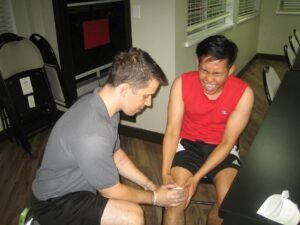The treatment for road rash is quite similar to the care provided for burns. Road rash involves rubbing off part or all of the skin and medically known as a skin abrasion.
Road rash basically involves skin that has been scraped off in an area on the body. The skin often appears raw and can bleed minimally. Take note that road rash is usually painful. In some cases, the depth of the road rash can cause nerve cell damage. Those who sustained this type of injury will not feel pain. Nevertheless, the skin surrounding the perimeters of the road rash can be very painful. You can learn more about proper management of a road rash by enrolling in a first aid class today.
Degree of road rash
You can easily measure the severity of a road rash. A first degree road rash involves redness of the skin and does not require treatment. As for a second degree road rash, it involves the outer layer of the skin but can recuperate on its own with insignificant scarring. A third degree road rash develops once the skin is completely removed and reveals the underlying tissue. The individual might require grafting of skin so that this degree of road rash can heal properly.

Proper cleansing of any dirt or debris
Individuals who sustained a road rash must wash all the dirt and debris from the wound. You can prevent infection by running water over the affected area and gently scrub away the debris. Once water and soap is available, wash the scraped area thoroughly and blot it dry using a towel.
An antibiotic ointment can be applied before the wound is bandaged to help with the healing process. If the individual is taken to the emergency department, the healthcare professionals will remove all the dirt and debris that remain after the initial cleaning. Just make sure that the individual is aware that the cleaning process can be painful. If there are debris and dirt left in the road rash, it can lead to tattooing or marks that are left beneath the skin by foreign objects after the wound has healed.
In some cases, others believe that a minor road rash is better left untreated after an initial cleaning. By allowing the scrape to scab and heal on its own, it can cause minor discomfort if the scab breaks. An open abrasion can lead to infection even after cleaning. A road rash that is infected can worsen the condition and take a longer time to heal.
Covering the road rash
Dressings that preserve moisture and protect the road rash can reduce the risk for infection and hasten the healing process. These wound coverings can reach 2-3 days without requiring a change unless the road rash oozes.
Avoiding sun exposure
Always bear in mind that road rash should be covered for about two weeks during the healing process. It must be covered from the sun for at least a month after the healing. You can apply sunscreen on the affected area to avoid permanent darkening of the skin.
